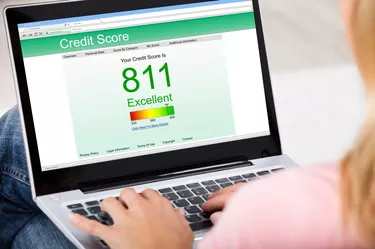
One unifying experience for many modern adults is anxiety over their credit scores. This seemingly magical three-digit number can feel like it controls your life. However, the method of determining where you fall in the credit score tiers can be obscure and arcane.
Credit Score Rating
Video of the Day
While there are a few credit score rating agencies, most top auto and finance companies will look at your FICO score first and weigh that more heavily than other ratings from other credit check organizations. FICO credit scores are created by the Fair Isaac Corporation, which was founded by the engineer Bill Fair and mathematician Earl Isaac in 1958 to create a rating scale to evaluate the risk a bank takes when lending money to a person based on that person's past financial activity.
Video of the Day
According to MyFICO.com, your FICO rating is based on five categories of financial history and your current financial situation. The amount of money you owe and your payment history make up 65 percent of the rating. The other three categories are weighed nearly equally, and include the length of credit history, credit mix and new credit.
What Is Considered in My FICO Rating?
You should understand what each of the five categories that are considered in a calculation of a FICO rating means, and what actions impact them negatively or positively. First, pay your debts on time or early. This impacts your payment history, and if you are regularly or even repeatedly late in paying your debts, your rating will be negatively impacted.
Second, keep the balance in your loan or credit accounts low. This impacts the amount you owe, and if you carry more debt overall, your credit score will suffer. Third, start your borrowing patterns early and keep your accounts active longer. According to Credit.org, this impacts your length of credit history. Having maintained a positive relationship with your lenders for longer is beneficial to your score.
You'll also want to diversify your credit. This means that having different types of credit, such as credit cards, loans or mortgages, can positively impact your rating. If you have many credit card accounts open but have never taken out a loan of any kind, your credit mix may be considered poor. Finally, try to avoid opening a new line of credit before attempting to take out a large loan or get a mortgage. With new credit, if you decide to open several credit cards or take out several loans in quick succession, it can look risky for lenders and will hurt your rating.
What Are the FICO Tiers?
Understanding the factors that impact your rating is one thing, but how do you interpret the actual number? Certainly, a higher number is better than a lower one, but where are the cut-offs and what do they mean for your financial situation? Credit score tiers are important to understand.
From 300 to 579 is considered a bad to poor credit rating, which will result in a credit card interest rate of approximately 24 or 25 percent. Scores from 580 to 669 are considered fair credit, which means that you have room for improvement. A credit card interest rate in this tier would be as low as 17 percent, which is a significant improvement over the first category. Between 670 and 739 is considered a good rating; this means that you can expect a credit card interest rate of roughly 14 percent. A FICO rating of above 740 is considered "exceptional," and you can expect an interest rate of 12 percent or sometimes less.